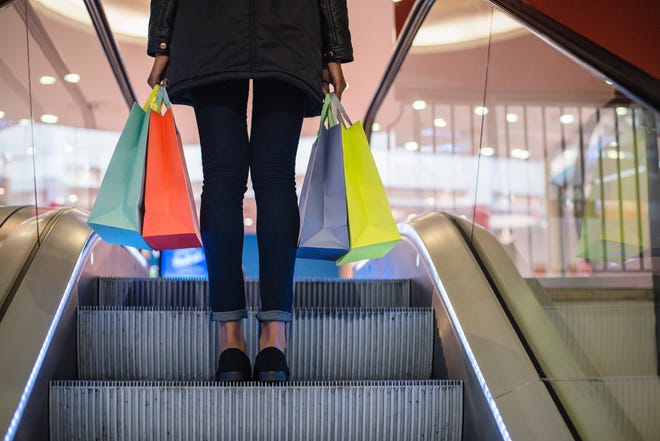
Inflation finally pushed Mark Hawkes to a breaking point.
So a few months ago, he canceled his gym membership.
“I can do workouts at home,” especially isometric exercises, says Hawkes, who is 62 and lives in Madison, South Dakota.
He also plans to downgrade his family’s cable TV service significantly, and may even cut the cord, relying on over-the-air TV and streaming services.
At the same time, he’s spending $2,500 to remodel his bathroom, a project that wasn’t exactly a must-do.
Protect your assets: Best high-yield savings accounts of 2023
“We really didn’t need to but my wife wanted to,” he says. “It’s a little dated.”
Two years after pandemic-related product and labor shortages pushed inflation to a 40-year high of 9.1%, the American consumer has become a study in contradictions. Households are broadly cutting their discretionary spending and making a decided turn toward the practical. But they’re still buying things they really want, analysts say.
Out? Clothing, furniture and dining out.
In? Vacations, concerts and jewelry.
Yes, jewelry.

“For categories where they find less expensive alternatives that fulfill their needs…they are doing that,” says Tamara Charm, a partner at McKinsey & Co., which surveys consumers and analyzes retail sales data.
At the same time, she says, “They have the economic means” to open their pocketbooks when they feel the compulsion.
What are consumers buying the most?
Americans are paring back the kinds of goods purchases that dominated their outlays while they hunkered down at home during the pandemic and cutting loose for experiences. But “they are particular about what (experiences) they are spending on,” Charm says.
While all age and income groups are scrimping and following these patterns to some extent, Charm says, lower-income households have been hit harder by inflation and are making basic choices as they juggle rent and other essentials. Credit card debt hit a record high late last year, though consumers paid off some of it in the first quarter. Delinquencies, mostly among lower-income segments, are at the highest level since 2011, according to the Federal Reserve.
Meanwhile, those less affluent households have largely depleted their pandemic stimulus checks and other savings.
Middle- to upper-income groups, by contrast, have seen their wages keep pace with inflation the past year but are being more discerning about how they spend those dollars, McKinsey says.
“The customer at the lower tier has to make choices based on rent and family obligations,” Macy’s CEO Tony Spring said during an earnings call late last month, according to an excerpt cited by Barclays. “The customer at the higher tier is going to do it based on where she has interest or they have interest and passion.”
Hawkes, who dropped his gym membership and is downgrading his cable service, says the moves were sparked by sharp increases in his car insurance and cable bills as well as a 15% jump in his property tax. He also plans to retire in five years and wants to ensure that he and his wife have an ample nest egg.
And while Hawkes is spending $2,500 on materials for the bathroom project, he’s doing the work himself to save on labor costs.
He and his wife are also planning a rare exotic trip this fall to Costa Rica or Hawaii but they’ll likely stay at an extended-stay hotel with a kitchen in the room to avoid pricey restaurant meals.
“We’re feeling the (price) pressure… a lot of ways,” he says.
Is inflation improving?
Annual inflation has fallen sharply from its 2022 peak, but progress has stagnated since fall and a report Wednesday is expected to show it held steady at 3.4% in May. Although the rate of yearly inflation is down sharply, that’s not providing much solace to consumers who continue to see prices climb and remember what they were before the run-up began in 2021.
“It’s the cumulative effect,” says Gregory Daco, chief economist at EY-Parthenon, adding that Americans are wrestling with “cost fatigue.”
Consumer sentiment fell sharply to a five-month low last month, according to a University of Michigan survey.
Is US consumer spending increasing?
Consumer spending, after adjusting for inflation, dipped in April after a solid first quarter and some economists wonder if that marked the beginning of a more sustained slowdown. Since consumption makes up about 70% of economic activity, such a scenario could jeopardize forecasts for a “soft landing” in which the Federal Reserve’s high interest rates slow inflation without causing a recession.
With lower-income groups struggling, it will likely be up to higher-income households to keep the economy afloat. The top 40% of income earners account for about 60% of all spending, Daco says. And in the first quarter, households with at least $100,000 in income were the only ones to increase their discretionary spending, according to Circana, which researches consumer behavior.
Overall, 40% of Americans say they’re splurging, down from 51% in 2021, McKinsey says.
How is inflation changing consumer behavior?
More affluent households, however, are showing some chinks in their financial armor. Even as they’re splurging many are also “trading down,” meaning they’re shopping at big-box discount stores or online to save on groceries and other staples, Charm says. Higher-income groups drove Walmart’s strong profits in the first quarter, company officials said.
And Americans in various groups are shelling out less on discretionary purchases to pay for essentials, Circana says.
“Many consumer pocketbooks are still stretched, and we see the effect of that in our business mix as they’re spending more of their paychecks on nondiscretionary categories and less on general merchandise,” Walmart Chief Financial Officer John David Rainey said during a call with analysts last month.
In grocery stores, shoppers are increasingly buying generic items instead of name brands, says Marshal Cohen, Circana’s chief retail industry adviser.
And they’re putting off buying some discretionary items as long as possible. That means they’re not purchasing sweaters until the temperature drops. Even then, “they’re saying, ‘Maybe I can get by without it’ if it’s a mild winter,” Cohen says.
Similarly, he says, they’re not replacing a recliner simply because it’s fraying. “If the chair breaks,” then they’ll buy a new one, he says.
Are people eating out less now?
Americans are also not dining out with abandon as they did when the pandemic faded, especially those in households with less than $75,000 in income. At least some of the time, 68% of people are switching from restaurant meals – whose bills are up 5.1% annually – to groceries, which have edged up an average of 1.2% in price, according to a recent survey by Vericast, a marketing technology company. Others are trading down from nice restaurants to casual dining or from the latter to fast food, according to McKinsey and Barclays.
Mike Jacobs, of Alexandria, Virginia, is a retired federal government worker who earns a six-figure pension, but he has scaled back from eating out a few times a week to once every few weeks. Prices, he says, have jumped more than 50% in the past few years.
Costco changes it upCostco is switching up how it sells books. What it means for shoppers.
“The service is lackluster,” he says. “Food portions have gotten smaller.”
So what are people buying?
Experiences such as vacations, concerts and some movies (think blockbusters like Barbie and Oppenheimer). Even jewelry qualifies as an experience because it enhances how a person looks when they’re out, Charm says. Jewelry, she adds, fell out of favor for a while but then consumers realized how much they still enjoy wearing it.
“If there is something they want that is at the right value, they will buy it,” she says.







